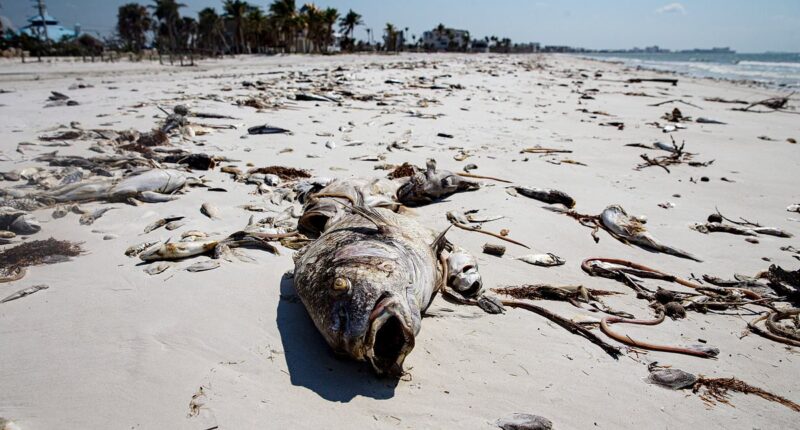Floridians are calling on Governor Ron DeSantis to declare a state of emergency as a toxic ‘red tide’ algae bloom worsens off the state’s southwest coast.
A red tide, so-named because it turns waters a rusty red color, is a type of harmful algae bloom (HAB) that occurs when the algae Karenia brevis grows out of control.
This species produces a neurotoxin called brevetoxin that disrupts the firing of nerve cells and can cause serious symptoms.
Skin contact has been known to cause irritation, and inhaling this chemical compound can cause shortness of breath, worsening of asthma, lung airway construction, bronchitis and pneumonia.
Eating seafood that has been contaminated with brevetoxin can also be dangerous, resulting in nausea, vomiting, diarrhea, changes in blood pressure, irregular heartbeat, facial numbness, dizziness, muscle aches and skin rashes.
The red tide currently covers more than 200 miles from Tampa Bay to Key West, and is still moving along the southwest coast.
Several Florida counties have issued health alerts in response to the toxic bloom that has been growing in the Gulf of Mexico since Hurricanes Helene and Milton stirred up nutrient-rich waters that feed the algae last fall, scientists say.
Dead fish have already washed up on several Florida beaches, and the outbreak is suspected to be tied to the deaths of two dolphins found offshore in Collier county.

A red tide, so-named because it turns waters a rusty red color, is a type of harmful algae bloom (HAB) that occurs when the algae Karenia brevis grows out of control (STOCK)

The Florida Fish and Wildlife Conservation Commission is currently monitoring the toxic algal bloom off the state’s southwest coast
‘While providing funds for engineering solutions, the government has not done a very good job at controlling or fixing polluted waterways,’ Eric Milbrandt, marine lab director of the Sanibel-Captiva Conservation Foundation (SCCF), told the Guardian.
The Florida Fish and Wildlife Conservation Commission is currently monitoring the bloom off the state’s southwest coast.
Over the past week, K. brevis was detected in 50 water samples collected from southwest Florida, with the highest concentrations found in samples from Sarasota County, Charlotte County, Lee County and Collier County.
Though red tides have become more common in Florida in recent years, they were never out of the ordinary. The state typically experiences at least one per year.
They most often form in late summer and early fall and persist through winter to spring, lasting for weeks or months.
And research has shown that water pollution makes them more likely to happen.
Pollutants that contain high amounts of nutrients such as nitrogen and phosphorous are the main drivers of more frequent red tides.
These include sewage and chemicals from agriculture or factories that contaminate water on the land, which eventually flows into the ocean as runoff.

Over the past week, K. brevis was detected in 50 water samples collected from southwest Florida, with the highest concentrations found in samples from Sarasota County, Charlotte County, Lee County and Collier County

Though brevetoxin is not typically considered fatal to humans, it can kill wildlife. Large amounts of dead fish typically wash up on Florida beaches during a red tide, like the one that occurred during March 2023 that left dead fish strewn across Fort Myers Beach
Algae feeds on the nutrients in these pollutants, making it easier for their numbers to explode when other conducive conditions arise, such as warm ocean temperatures or storms that kick up more nutrients stored in sediment from the ocean floor.
Runoff water pollution is difficult to tackle, because it doesn’t have a single source that can be eliminated. Instead, it stems from many different farms, factories or sewage treatment plants that are all emitting chemicals into the groundwater.
‘We have a lot of them in the state of Florida,’ Milbrandt said. ‘It’s great that the state has been investing in engineering technology, and it does have promise, but it likely would be limited to smaller blooms.’
In 2019, Governor DeSantis appointed 11 researchers and leading scientists to a Red Tide Task Force and has since approved $125 million in funding for the development of mitigation strategies and technologies.

During a June, 2023 red tide in Florida, two Pinellas County Sherriff’s Office Deputies held a manatee’s head above water for two hours after finding the animal too ‘exhausted’ to prevent itself from drowning

While Florida environmentalists have praised Governor Ron DeSantis’ investments in red tide mitigation strategies and technologies, they are calling on him to respond to the latest bloom as an emergency and to address polluted waterways that make red tides more common
But in addition to addressing water pollution, Milbrandt said Florida needs to change the way it responds to these events when they arise.
‘From a response perspective, it should be kind of an emergency management response like a hurricane,’ he said.
DailyMail.com has reached out to the office of Governor DeSantis for comment.
In addition to the health risks red tides pose to people and wildlife, their impacts on tourism, fishing and other industries can result in billion-dollar losses for Florida.
A bloom in 2018, for example, caused $2.7 billion in tourism losses.
Milbrandt hopes that speaking out will result in changes to the way Florida deals with this pervasive environmental threat.
‘We just want something to happen here,’ he said. ‘A statewide approach, like an emergency management approach, would be useful.’
















